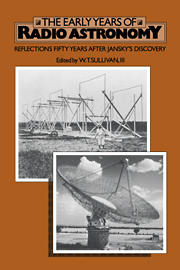Book contents
- Frontmatter
- Contents
- Preface
- THE EARLIEST YEARS
- AUSTRALIA
- ENGLAND
- The origins and early history of Jodrell Bank
- Paraboloids, galaxies and stars: memories of Jodrell Bank
- Early work on radio stars at Cambridge
- The development of aperture synthesis at Cambridge
- THE REST OF THE WORLD
- BROADER REFLECTIONS
- Biographical notes on contributors
- Name index
- Subject index
Paraboloids, galaxies and stars: memories of Jodrell Bank
Published online by Cambridge University Press: 05 March 2010
- Frontmatter
- Contents
- Preface
- THE EARLIEST YEARS
- AUSTRALIA
- ENGLAND
- The origins and early history of Jodrell Bank
- Paraboloids, galaxies and stars: memories of Jodrell Bank
- Early work on radio stars at Cambridge
- The development of aperture synthesis at Cambridge
- THE REST OF THE WORLD
- BROADER REFLECTIONS
- Biographical notes on contributors
- Name index
- Subject index
Summary
SOME EARLY WORK WITH THE 218 FT PARABOLOID
Introduction
I shall always remember reading an article on “Cosmic Static” which Grote Reber published (Reber 1940) in the February 1940 issue of the Proceedings of the Institute of Radio Engineers. It was during World War II and we were working desperately hard on various “advanced” forms of airborne radar for the detection of ships, submarines and aircraft. Reber's strange article was sandwiched in between conventional papers on frequency modulation and negative feedback and, because it was so intriguingly odd, it lay open on our laboratory bench for several days until, inevitably, someone put a hot soldering iron down on it. Reber had worked at much the same frequency (160 MHz) as we had been using for airborne radar for several years, and I couldn't help thinking how nice it would be to turn some of our relatively “superior” equipment on to the sky to see if his “cosmic static” was really there. It was not until nearly a decade later that I was given the opportunity at Jodrell Bank.
In 1949 I was a partner in a firm of consulting engineers with Sir Robert Watson-Watt, the pioneer of radar. Sir Robert wanted to move our firm to Canada – which he did with disastrous results – and I did not. Instead I decided to stop advising firms on research and do some myself, perhaps in a University. As a start I went to see my old friend and wartime colleague F.C. Williams in Manchester; he suggested that I should take a look at what Bernard Lovell was doing at Jodrell Bank.
- Type
- Chapter
- Information
- The Early Years of Radio AstronomyReflections Fifty Years after Jansky's Discovery, pp. 213 - 236Publisher: Cambridge University PressPrint publication year: 1984

